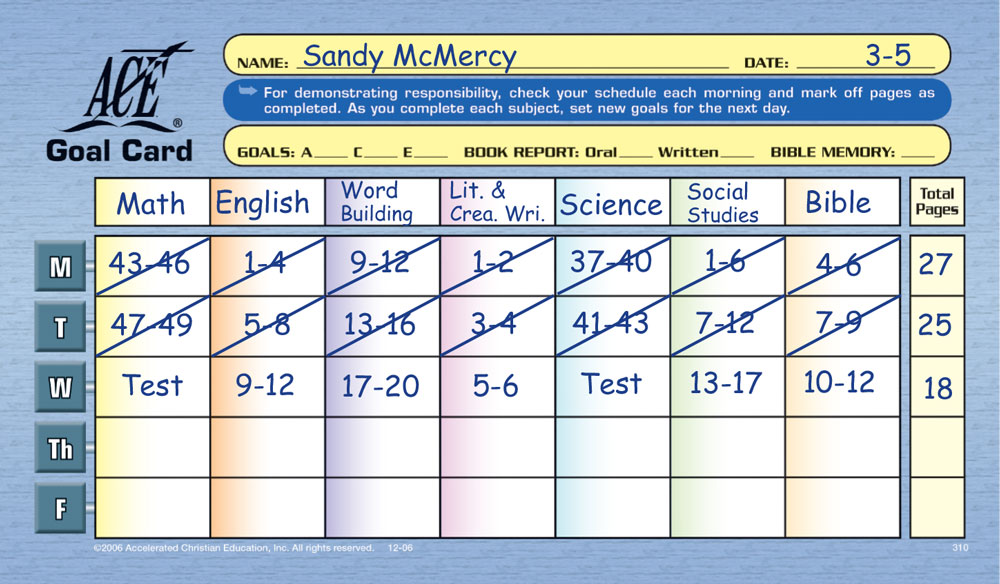He made a pit, and digged it, and is fallen into the ditch which he made. Psalm 7:15
The practice of making pitfalls has been an often-used method for trapping wild animals and has also been a strategy used against enemy soldiers in times of war. Sometimes a man, having made such a pit, covered it over so completely that he fell into his own trap. Sometimes a supervisor can inadvertently create pitfalls that are hidden and whose danger is not easily recognized. Here are 12 such pitfalls you will want to avoid.
Pitfall #1
Overloading students with gap PACEs when diagnostic tests reveal that they are weak in several PACEs (in one subject) below their performance levels.
Proper Procedure: If a student misses a concept found two levels or more below his performance level, prescribe a “gap” PACE from the highest level in which the concept is taught but that is still below his performance level. The goal is to strike a balance between ensuring the student learns any missed concepts and not unnecessarily overloading a student with gap PACEs. If the highest PACE in which the concept is taught is assigned and you see that the student is struggling, a lower-level PACE in which the concept is taught is prescribed. Gap PACEs, whether above or below 1097, may be taken for elective credit (for high school transfer students only); but Honors, College Preparatory, or General students must still complete all required courses. Vocational Preparatory students receive full credit toward graduation for PACEs completed at performance level through 1096.
Pitfall #2
Allowing a student to take the PACE Test the same day the PACE is turned in.
Proper Procedure: The PACE Test is given to the student the next school day at the testing table with a word of encouragement and prayer with the staff. Waiting at least until the next day (try to avoid Monday morning testing) before allowing the student to take the PACE Test will put the information learned into his long-term memory. If the learning is only short-term, additional learning gaps may be formed.
Pitfall #3
Allowing students to pass PACE Tests with a score less than 80 percent.
Proper Procedure: If a student scores above 80 percent, he advances to the next PACE in his prescription. If not, review the Test by asking yourself these questions. Was the student careless in matching or computations? Is his answer an acceptable synonym or alternative? Was his handwriting so poor the staff did not recognize the intended word? If the student does not understand the material, he must fail the Test and be issued a repeat PACE. Staff may be tempted to make allowances for negligence. When a supervisor moves the line once, it becomes easier the second time, and still easier the third time. There is the danger of an 80 percent score turning into 79 percent, then 78 percent, until mastery is no longer the standard. An 80 percent score indicates mastery. As stated in Procedures Manual I, “Train the student to do his best the first time, and with proper motivation and controls, he will try to excel.”
Pitfall #4
Not requiring students to repeat failed PACEs in their entirety.
Proper Procedure: When a student scores below the minimum score of 80 percent on the PACE Test, he must repeat the entire PACE. Do not permit just a review of the PACE before retaking the PACE Test. Allowing shortcuts gives the student permission to learn only enough to pass the Test. Remember, mastery of the material is the goal, not passing the PACE Test, Honor Roll, or a field trip. (All reasons for which one may be tempted to take a shortcut.) Failure to follow the Procedures Manual will create future learning difficulties and perhaps a learning gap. Repeating a PACE helps the student realize the importance of learning the material thoroughly. Keep the responsibility of learning on the student’s shoulders. When issuing the new PACE, increase the goals to allow a quick completion, and ask him to score carefully and to correct all errors before proceeding. If the student masters the material, he will be able to build on it easily in the future rather than trying to learn it for the first time along with learning the new concept being added.
Pitfall #5
Neglecting to have students follow the recommended procedure for correcting incorrect responses on Checkups and Self Tests.
Proper Procedure: Students who miss questions on Checkups or Self Tests demonstrate a lack of mastery of the material. On Checkups the student should find the correct answer in that section of the PACE and replace the wrong answer with the correct one. Once the student has the correct answer to all missed questions, he raises his flag for permission to return to the scoring station to rescore his work. If the answer is correct, the student circles the red “X” placed beside the question when he first scored the material, then returns to his office. He thoroughly reviews all material in that section, especially questions missed, before moving to the next section. For Self Tests the student must find the correct answer from the PACE and rescore. He should thoroughly review the entire PACE, especially questions missed on Checkups and the Self Test, before requesting to take the PACE Test. Train students to be honest.
Pitfall #6
Giving students the answer instead of training them to find the answers themselves.
Proper Procedure: The supervisor’s responsibility is not to answer the student’s questions for him but to ask leading questions to determine the nature of the problem, to focus the student’s attention on finding the solution, and to guide him to find the answer. For a student to become a good learner, supervisors must avoid the temptation to be the student’s only source of information. In the conventional classroom, the teacher has been “the sage on the stage.” The supervisor’s role is to be “the guide on the side.” The answer is not the most important thing—training the student to find the answer is. Make sure he reads and understands the directions (have him read and state the directions in his own words) and knows what reference sources are available. In math, have him show his work and check to see that the correct answer can be achieved with the work shown (he didn’t just copy the answer). If the student comes to depend on you for the answers, you fail to train him to be a learner. Two kinds of supervisors are prone to this pitfall.
First, there is the undiscerning supervisor who fails to recognize the specific needs and abilities of students and makes an inaccurate judgment of how to best help them. An undiscerning supervisor may see a student struggling with an activity and may intervene too early with suggestions like, “Here’s how you do that” or “You don’t have to do that activity (or that page); it’s too difficult” and strikes out the activity or section with his green pen. The student’s opportunity to learn problem-solving skills has been short-circuited because the supervisor failed to discern the student’s need to find the answer for himself. He inadvertently created gaps for the student. Supervisors must help students develop critical thinking and problem-solving skills—not solve the problems for them!
Second, there is the distressed supervisor who lacks perseverance to do everything possible to help students succeed academically. He knows what needs to be done to help each student, but when he sees all the Christian flags to be answered, he reasons—I don’t have time now to answer all those flags. So he hurriedly answers the student with “Here’s the answer” or “Here’s the Score Key—find the answer.” The supervisor may be saving his time, but he is not helping the student discover answers for himself. He may give the answer to one activity only to realize the student raises his flag again for the next activity and wants the answer. This supervisor becomes an economic liability to the school and may lead to the need for additional staff.
“Give a man a fish and he will eat for a day. Teach him how to fish and he will eat for a lifetime.”
Pitfall #7
Relaxing or failing to enforce scoring procedures.
Proper Procedure: When a score strip appears, the student raises his national flag to request permission to score his work. A staff member quickly reviews the work to be sure it is completed. The student goes to the scoring station with only his PACE. While at the scoring station, the student uses a red pen provided at the scoring station to make a red “X” beside the number of any incorrect answers and a red “X” in the first box of the score strip. Instruct students in correct Score Key usage and provide careful but reasonable supervision of the scoring station. Minimize the possibility for students to obtain answers from Score Keys without arousing feelings of distrust by making the student aware of the staff’s presence. It is easy for the Learning Center staff to become involved with students and not pay attention to what is going on at the scoring stations. While working with students, occasionally turn around and look. You don’t have to look at anyone or anything in particular, but students will notice that you turned around. When pastors and administrators come to the Learning Center, stop at the door for 30 seconds and look. Again, you don’t have to look at anyone or anything in particular, but students will notice that you looked. Regularly spot-check scoring for “carelessness.” Staff members should occasionally scan students’ PACEs, looking specifically for proper scoring procedures and to detect marked answers (thumbnail marks, red dots, “strategically” placed red “Xs,” heavy pencil writing covering up red ink, pencils in ties or under fingernails, camera phones at scoring station taking pictures of Score Keys, etc.). Scoring procedures are predicated on honesty but offer many opportunities to present the character trait of honesty as well. Address the “heart issue” of honesty in devotions and chapels to “shut the gate before the horse gets out.” You may want to watch the use of camera cell phones and text messaging, iPods with wireless earpieces with notes read into them, and programmable calculators, especially at the testing table.
Pitfall #8
Failing to do a daily goal check for every student.
Proper Procedure: Understanding that 1 monitor works with approximately 30 students, the monitor checks goals uninterrupted during the first 45 minutes each morning. The previous day’s goals are checked for completion, and the new goals for the current day are reviewed. PACE subjects in which the student may need academic assistance are noted. The goal check is one of the nuts and bolts of the A.C.E. system of learning. Without a daily goal check, the A.C.E. system will not achieve the intended academic results. This is a school’s single greatest academic control. If this procedure is not followed, the supervisor really has no idea where each student is academically. A goal check will spot problems (in understanding, scoring, completion of goals, etc.) very early, before they mushroom or snowball. The monitor should be sure the student has accomplished a specific activity during a day for which he wrote “Review” or “Study” on his Goal Card. Make sure the student has not adjusted his goals without the supervisor’s permission, initialed in green on the Goal Card. If the Goal Check Report is the school’s only attendance record, make sure attendance is accurately recorded for each student each day.

Pitfall #9
Failing to quiz students before giving Self Test initials.
Proper Procedure: Before initialing the Self Test, quiz the student on activities marked with “Xs.” Check the student’s readiness for the Test by quizzing him over important concepts and activities that he missed in the PACE, especially on Checkups. Also, quiz him on questions he did not miss to verify comprehension of concepts. A student who is not ready to take the Self Test should be given specific instructions on how to prepare, such as, “Review the vocabulary,” “Memorize the formula on page 17,” and “Review this list of items.” You may also need to give the student some individual instruction. Have written practice exercises available for students who are uncomfortable answering your questions orally. However, for some students, this could be a sign that they did not fully comprehend the material.
Pitfall #10
Failing to make sure students are adequately supervised at all times.
Proper Procedure: Learning Center staff responsibilities include supervising student scoring and testing, supervising the playground and privilege area, and supervising extracurricular activities. From the beginning until the end of daily activities, the staff is involved with students rather than with materials. No matter how good your students are, “You get what you inspect, not what you expect.” If a large Learning Center or more than one Learning Center is sent on break at one time, at least two adults need to be supervising in different places. If they stand next to each other, they will talk and not watch the children. Every school has a Tommy or a Sally who, if you give them three nanoseconds, will be hanging from the cross on the steeple. Some of the best character training opportunities are informal ones that arise when staff is supervising various student activities. Do your best to help the students be accountable while maintaining an attitude of trust. Failing to be fully engaged robs you of the opportunity to be a Godly example.
Pitfall # 11
Relying on only negative motivation to control and motivate students.
Proper Procedure: Experienced staff learn to use positive motivation techniques as a balance to negative controls to motivate and control students. Reinforce and reward positive behavior. Do not wait for a child to achieve perfection or to score 100 percent. Look for little steps in achievement, character, or progress and build on those. Encourage students often to encourage their hearts. Use all of the suggestions in the Procedures Manual for positive motivation (Congratulations slips, stars, stickers, Privilege Status and a Privilege Area, Honor Roll, field trips, Honor Roll trips, and green dot treats).

Pitfall #12
Failure to keep good lines of communication open between the Learning Center staff and the home.
Proper Procedure: Keep the home informed through a weekly or monthly newsletter and properly use the Corrective Action Notice and Homework Assignment forms. Provide parents with staff contact information. Conduct regular parent/supervisor conferences, and agree to practice a “benefit of the doubt” policy. Provide both a monthly and yearly school calendar to avoid, “Why didn’t you tell me?” The effectiveness of the school depends upon successful parent-staff communication. Address problems while they are small. Finally, make sure parents understand the benefits of an individualized curriculum, including the advantages of academic diagnosis, individualized attention, and goal setting. Informed parents are happy parents.

